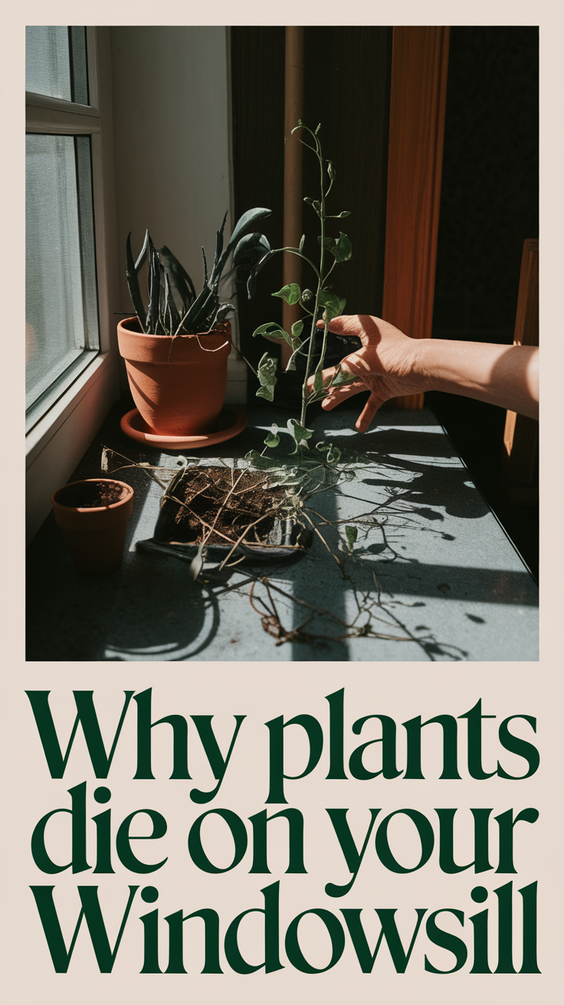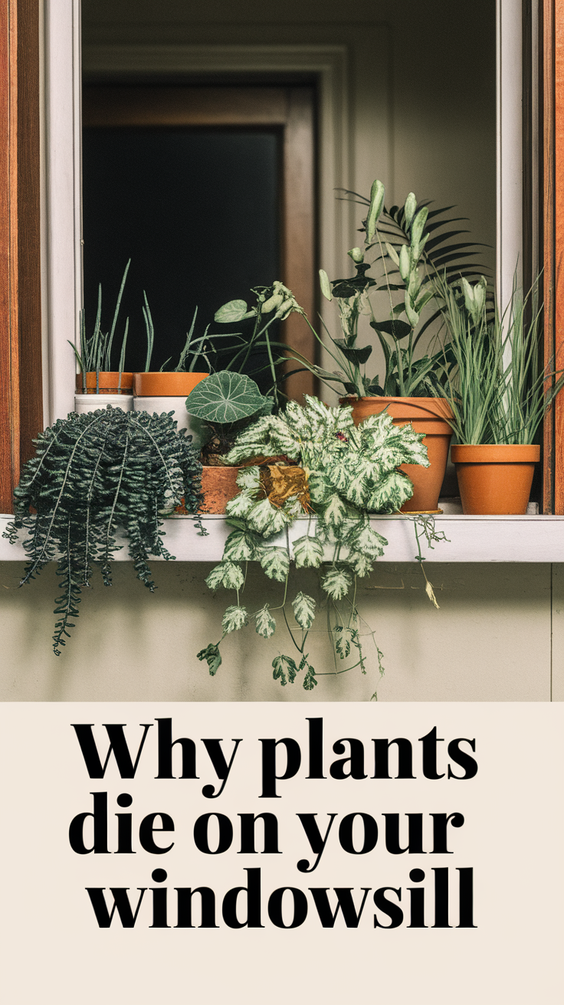Why Plants Die on Your Windowsill in 2025: Common Mistakes and How to Fix Them
Did you know that over 60% of indoor plants die within three months of purchase?
If you’ve lovingly placed a green friend on your windowsill only to see it wither away, you’re not alone. In 2025, the trend of indoor gardening is booming—yet many people struggle to keep their plants alive. So what’s really going on behind those drooping leaves?
In this guide, we’ll walk through the top reasons why plants die on your windowsill, what warning signs to watch for, and how to revive your plant-care routine with smart, practical tips. Whether you’re a new plant parent or have a home full of pots, this article will help you prevent the common mistakes that are killing your houseplants.
The Real Reasons Why Plants Die on Your Windowsill
Overwatering or Underwatering: The #1 Killer of Houseplants
It’s easy to assume that more water equals more life—but that’s rarely true. In fact, most plant deaths come from root rot caused by excess moisture.
Signs of overwatering:
-
Yellowing leaves
-
Mushy stems
-
Moldy soil surface
Signs of underwatering:
-
Crispy leaf edges
-
Wilting
-
Soil pulling away from the pot edges
Solution: Learn your plant’s specific water needs. A cactus doesn’t need the same care as a fern. Use your finger to test moisture, or invest in a soil moisture meter for accuracy.
💡 Tip: Always check that your pot has a drainage hole. No drainage = waterlogged roots.
Wrong Light Conditions: Too Much or Too Little
Many people place plants near a window assuming that’s enough light. But not all windows—and not all plants—are created equal.
Too much light can scorch leaves, while too little leads to pale, leggy growth. A sunny south-facing window may be ideal for succulents but deadly for shade-loving plants like peace lilies.
Solution:
-
Use a compass app to determine window orientation.
-
Add sheer curtains to filter harsh sun.
-
Try LED grow lights for darker rooms.
How well do you really understand your plant’s light requirements?
Temperature Fluctuations and Drafts: A Hidden Threat
That cozy spot by the window might be exposed to freezing air in winter or become an oven in summer. Many windowsills in American homes are near radiators, AC units, or drafty panes.
Common issues:
-
Sudden leaf drop
-
Burnt leaf tips
-
Slowed growth
Solution:
Keep plants away from vents, heaters, or poorly insulated windows. A digital thermo-hygrometer can help monitor indoor conditions year-round.
Less Obvious but Equally Deadly Mistakes
Old Soil and Lack of Repotting
When was the last time you repotted your plant? Over time, soil becomes compacted and loses nutrients. This suffocates the roots and starves the plant.
Warning signs:
-
Roots growing out of the pot’s drainage holes
-
Soil that stays soggy or dries out too fast
-
Stunted growth despite watering
Solution:
Repot your plant every 1–2 years using fresh potting mix tailored to its needs. For example, orchids need bark-based mixes, not standard soil.
Pest Infestations: Out of Sight, Out of Control
In 2025, with rising indoor humidity levels and increased plant trade, houseplant pests are more common than ever.
Culprits to watch for:
-
Spider mites: leave fine webbing and speckled leaves
-
Mealybugs: look like white cotton balls on stems
-
Fungus gnats: small flying insects, especially in damp soil
Solution:
-
Inspect new plants before bringing them home
-
Isolate infested plants
-
Use neem oil or insecticidal soap for treatment
Have you checked the underside of your plant’s leaves lately?
Chemical Exposure and Toxic Residues
Scented candles, aerosol sprays, and even window cleaning agents can harm sensitive plants. Leaves absorb chemicals from the air, especially in tight spaces.
Solution:
-
Avoid spraying anything near your plant
-
Wipe leaves with a damp microfiber cloth weekly
-
Use natural cleaning solutions around your indoor garden
Mistakes First-Time Plant Parents Make
Choosing High-Maintenance Plants Without Research
Orchids, calatheas, and fiddle-leaf figs look beautiful on Instagram—but they’re not beginner-friendly.
Instead, start with hardy species like:
-
Snake plant (Sansevieria)
-
ZZ plant
-
Pothos
-
Spider plant
-
Peace lily
Here’s a quick comparison table:
| Plant Name | Light Needs | Watering Needs | Difficulty |
|---|---|---|---|
| Snake Plant | Low to bright | Rarely | Very easy |
| Fiddle Leaf Fig | Bright indirect | Weekly | Difficult |
| Pothos | Low to medium | Moderate | Easy |
| Calathea | Indirect, humid | Frequent | Tricky |
Following Generic Advice Instead of Observing Your Plant
“Water every 3 days” might work for one plant—but it’s deadly advice for another. Your windowsill has its own microclimate depending on the time of year, wall insulation, and room use.
Solution: Get to know each plant individually. Watch how it reacts, adjust accordingly.
🧠 Fun Fact: Plants “communicate” with you—through drooping, color changes, and leaf texture. Are you paying attention?
A Step-by-Step Rescue Plan for Your Fading Plant
Step 1: Check Light Conditions
Is the plant stretching toward the window or showing faded leaves? Adjust placement or supplement with artificial light.
Step 2: Inspect Soil Moisture
Use a finger or moisture meter. Is it soggy or bone-dry? Adjust watering accordingly.
Step 3: Examine for Pests
Look at stems, under leaves, and in the soil. Treat immediately if bugs are spotted.
Step 4: Review Pot and Soil
Repot if roots are cramped or if the soil looks degraded. Choose the right mix.
Step 5: Set a Care Routine
Use a calendar or app (like Planta or Greg) to track watering, fertilizing, and repotting.
Latest Plant-Care Trends in 2025
-
Smart pots with built-in sensors for light and moisture
-
Voice-controlled grow lights compatible with Alexa or Google Home
-
Rising use of organic, peat-free potting mixes
-
Emphasis on native and air-purifying plants
Common Symptoms and What They Mean
Here’s a handy cheat sheet:
| Symptom | Likely Cause | Fix |
|---|---|---|
| Yellow leaves | Overwatering | Cut back on watering |
| Brown edges | Low humidity or salt | Mist leaves, flush soil |
| Droopy stems | Lack of light or root rot | Adjust light, check roots |
| Sticky residue | Pests like aphids | Clean and treat with soap |
| No growth | Nutrient deficiency | Use gentle, balanced fertilizer |
What If the Plant Is Nearly Dead?
Sometimes, despite best efforts, the plant is beyond saving. But you might still be able to propagate it!
Try this:
-
Cut off healthy-looking stems
-
Place in water or fresh soil
-
Monitor for new root growth
If nothing works—don’t feel guilty. Every failed plant is a lesson, not a failure.
Conclusion: How to Keep Your Plants Alive and Thriving
Let’s recap what you’ve learned:
-
-
Most houseplants die from overwatering or poor light, not neglect.
-
Your windowsill environment plays a bigger role than you think.
-
-
Observing your plant is the best way to learn what it needs.
-
With the right tools and care, even “brown thumbs” can succeed.
So—what’s your biggest plant-care struggle right now?
Drop your experiences in the comments and share this article with a fellow plant lover!



